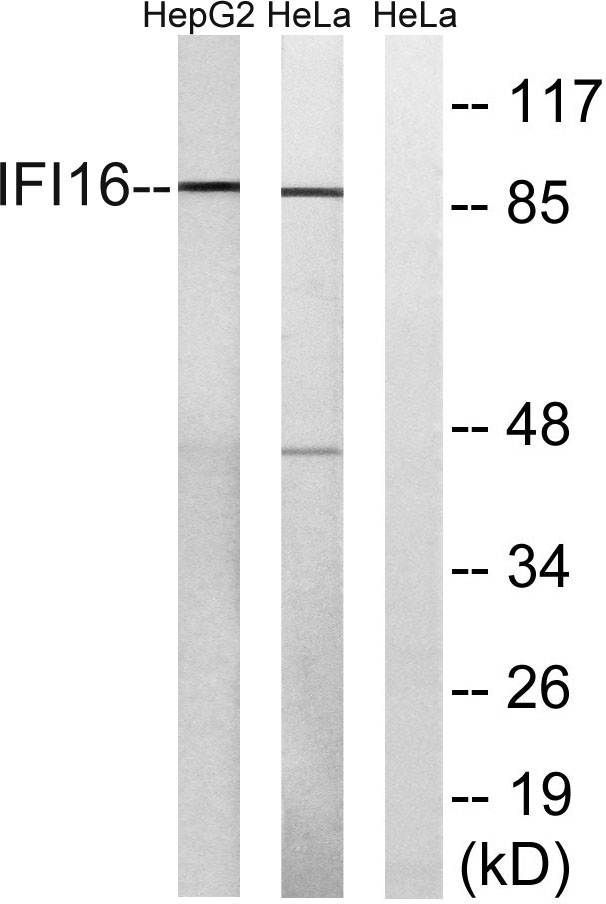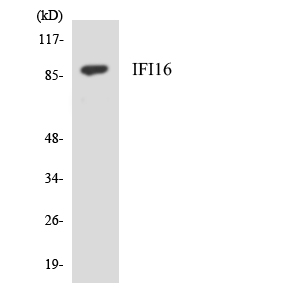产品名称
IFI-16 Rabbit Polyclonal Antibody
别名
IFI16; IFNGIP1; Gamma-interferon-inducible protein 16; Ifi-16; Interferon-inducible myeloid differentiation transcriptional activator
蛋白名称
Gamma-interferon-inducible protein 16
存储缓冲液
Liquid in PBS containing 50% glycerol, 0.5% BSA and 0.02% New type preservative N.
Human Gene Link
http://www.ncbi.nlm.nih.gov/sites/entrez?db=gene&term=3428
Human Swissprot No.
Q16666
Human Swissprot Link
http://www.uniprot.org/uniprotkb/Q16666/entry
免疫原
The antiserum was produced against synthesized peptide derived from human IFI16. AA range:731-780
特异性
IFI-16 Polyclonal Antibody detects endogenous levels of IFI-16 protein.
稀释度
WB 1:500 - 1:2000. ELISA: 1:40000. Not yet tested in other applications.
宿主
Polyclonal, Rabbit,IgG
背景介绍
This gene encodes a member of the HIN-200 (hematopoietic interferon-inducible nuclear antigens with 200 amino acid repeats) family of cytokines. The encoded protein contains domains involved in DNA binding, transcriptional regulation, and protein-protein interactions. The protein localizes to the nucleoplasm and nucleoli, and interacts with p53 and retinoblastoma-1. It modulates p53 function, and inhibits cell growth in the Ras/Raf signaling pathway. Alternatively spliced transcript variants encoding different isoforms have been found for this gene. [provided by RefSeq, Apr 2011],
组织表达
Expressed in peripheral blood leukocytes, fibroblasts and lymphoid cells. Present in myeloid precursors (CD34+) and throughout monocyte development, but its expression is down-regulated in erythroid and polymorphonuclear precursor cells. Present in prostate, ovary and breast (at protein level).
细胞定位
Nucleus. Cytoplasm. Cellular distribution is dependent on the acetylation status of the multipartite nuclear localization signal (NLS); NLS acetylation promotes cytoplasmic localization. Localizes in the nucleus during human herpes simplex virus 1 (HHV-1) infection.
功能
function:May function as a transcriptional repressor. Could have a role in the regulation of hematopoeitic differentiation through activation of unknown target genes. Controls cellular proliferation by modulating the functions of cell cycle regulatory factors including p53/TP53 and the retinoblastoma protein. May be involved in the senescence of prostate epithelial cells.,induction:Strongly induced by gamma interferon and, to a lesser extent, by alpha interferon. In HL-60 cells, maximum induction by gamma-interferon occurs within 12 hours whereas, for alpha-interferon, only 10-fold induction was observed after 36 hours. Induced in vitro by dimethylsulfoxide, retinoic acid and 1,25 dihydroxyvitamin D3.,PTM:Isoform 3 seems to show a minor degree of complex carbohydrate addition.,PTM:Phosphorylated on Ser and Thr.,sequence caution:Intron retention.,similarity:Belongs to the HIN-200 family.,similarity:Contains 1 DAPIN domain.,similarity:Contains 2 HIN-200 domains.,subunit:Isoform 1, isoform 2 and isoform 3 can homo- and hetero-dimerize. Binds double-stranded DNA and cell cycle regulatory factors including p53 and the retinoblastoma protein.,tissue specificity:Expressed in peripheral blood leukocytes, fibroblasts and lymphoid cells. Present in myeloid precursors (CD34+) and throughout monocyte development, but its expression is down-regulated in erythroid and polymorphonuclear precursor cells. Present in prostate, ovary and breast (at protein level).,
纯化
The antibody was affinity-purified from rabbit antiserum by affinity-chromatography using epitope-specific immunogen.


